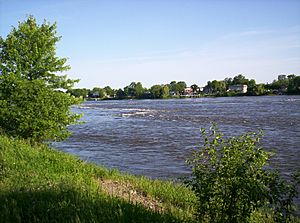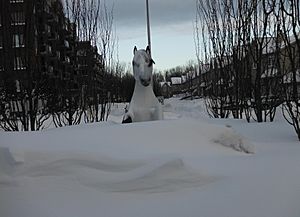Rapides du Cheval Blanc facts for kids
Quick facts for kids Rapides du Cheval Blanc |
|
|---|---|

Rapides du Cheval Blanc Park
|
|
| Lua error in Module:Location_map at line 420: attempt to index field 'wikibase' (a nil value). | |
| Location | Pierrefonds-Roxboro, Montreal, Quebec, Canada |
| Operated by | City of Montreal |
There are three locations in Quebec, Canada with the name "Rapides du Cheval Blanc". This article is on the rapids between the north side of the Island of Montreal, and the south side of Sainte-Dorothée, Laval.
The Rapides du Cheval Blanc, or White Horse Rapids, flow between the Island of Montreal, Pierrefonds-Roxboro and Sainte-Dorothée, Laval on the Rivière des Prairies in Quebec. The name also refers to a protected woods, a public city park adjacent to the rapids, and to a fault line underneath the area. The rapids are visible at the public park. The name "Rapides du Cheval Blanc" is applied to a large area.
Contents
History
The name Whitehorse or Cheval Blanc comes from several legends, one of which is 18th-century legend of a white horse that would emerge from the Rivière des Prairies, and terrorize villagers and ravage crops. Another legend says a horse was pulling a cart on a ferry across the river to Île Bizard when the cable connecting the ferry to the shore broke and it drifted downstream. At the height of the rapids, the horse escaped. Another legend is that of a white horse that carried the materials for the construction of the Church of Sault-au-Récollet jumped aboard a boat in the middle of the rapids.
The land being next to the Rivière des Prairies is subject to spring flooding and has flooded many times in the past.
Ownership of the River
The river is owned by both the Federal and Provincial governments. The Federal government, Fisheries and Oceans Canada polices the water, the Provincial polices the earth, the bottom of the river and the north and south shorelines. Floating buoys are placed in the river during the summer to aid boat navigation.
The river cleanliness is usually good according to the RSMA (Réseau de suivi du milieu aquatique) water testing that is done weekly during warm weather. Rapides du Cheval Blanc is numbered RDP-180. The river temperature can be found on the RSMA (Réseau de suivi du milieu aquatique) water quality report, it peaks at 25 °C (77 °F) in the months of July and August.
Ownership of the Land
The original owners of the land were of course the Aboriginal peoples and the Algonquin people. Explorers from France named the land New France and the parish of Sainte-Geneviève was founded in 1741. Treaty of Paris (1763) ceded Canada and most of New France to Britain after the Seven Years' War. In 1775-1776 the Island of Montreal was under attack from America, Fort Senneville was destroyed in 1776. Treaty of Paris (1783) ended the American Revolutionary War. The nation of Canada formed July 1, 1867.
Historical maps show boundary lines of the farmers fields using the Seigneurial system with names associated to the land. From East to West the names on the Henry Whitmer Hopkins map (year 1879) are
- Lot 49 Jos Legault
- Lot 51 M. Lelande (Lalande)
- Lot 52 P. Legault
- Lot 55 N. Lelande (Lalande) Where the public park overlooks the rapids is today. The north end of the street "Riviera".
- Lot 62 Jos. Legault
- Lot 67 Berthiaume
- Lot 68 Jos. Brunet
- Lot 75 M. Langerin
- Lot 76 Jos. Langerin
- Lot 77 N. Cardinal
- Lot 86 Cardinal
- Lot 87 Richermois
- Lot 92 Jos. Theoret
Aerial photographs of 1947 show that the Cheval Blanc land was agricultural at that time. When the Deux-Montagnes (original name Canadian Northern Railway) railway was built through the land during the years 1912-18, many fields were cut off from their original parcel of farmland, resulting in triangle shaped properties.
Presently on the undeveloped lots or properties, the Habitant-farmers boundary lines still exist and are visible as 3 feet wide by 3 feet tall stone walls, also many of the farmers apple trees can still be found in the woods.
Residential development began to replace the farmland in 1953.
The location in the river was officially named in 1968 by the Gouvernement du Québec and Natural Resources Canada.
On June 26, 1968 the road, Sources Boulevard was voted to be extended north, past the train tracks. In doing so, building could then take place on the land adjacent to the rapids.
The land was being considered as a place for a million dollar apartment building in 1972.
A petition of George Boutellier that had over a thousand names was presented to then Mayor Eddie Lalande in an attempt to protect the land from development in 1972, but it was ignored.
On December 2015 the sum of $3,431,280 was paid by Réal Ménard the Montreal Executive Committee member responsible for green spaces, to the owner of Lot 1 171 908 on behalf of the city of Montreal. The land located at 1 171 908 was originally designated unbuildable floodplain valued at $1.00, then rezoned, then valued at $452,600 in 2014-2016 .
Rapides du Cheval Blanc Park
The land was being considered as a "Promenade" park as early as 1974.
According to the Gouvernement du Québec and Natural Resources Canada, a public park was created in 1997 on the site of a former sewage treatment plant. The sewage plant was on Lot 67 and Lot 62.
The current nature park, a further expansion of the 1997 park, was finally created in 2009.
On August 8, 2019, the City of Montreal announced a plan to include the Rapides du Cheval Blanc Park into the future Grand Parc de L’Ouest.
Debris Pollution Problem Areas
A significant portion of the land that is close to 5th Avenue North that was purchased Dec. 2015 has construction debris, such as red brick, on the property. After sunset, in the months of June and July fireflies can be seen in this area, from the bicycle path that is west of 5th Avenue North.
North of the street "Rue du Sureau", east of the Canada Post mailbox's, cement and rebar debris can be seen on the side of the road.
Wildlife
Wild animals that can be found on the land near the rapids are rabbits, squirrels, snakes, chipmunks, turtles, cardinals, seagulls, sandpipers, herons, ducks, geese, chickadees and finches.



